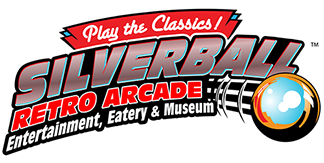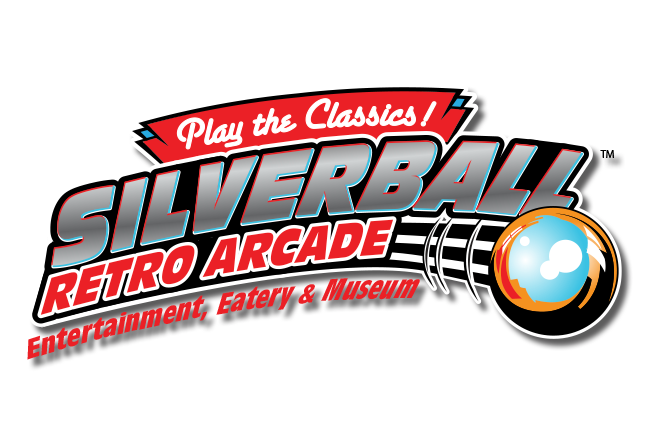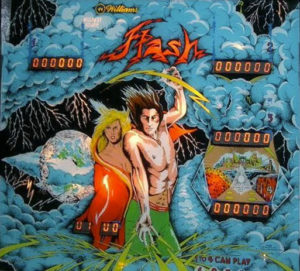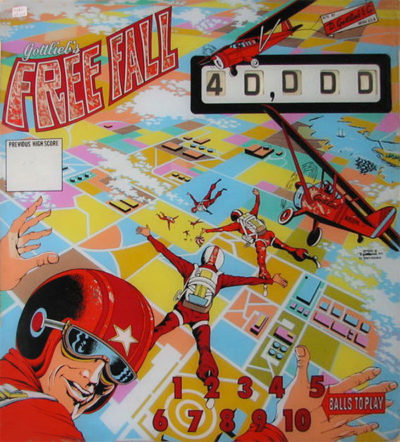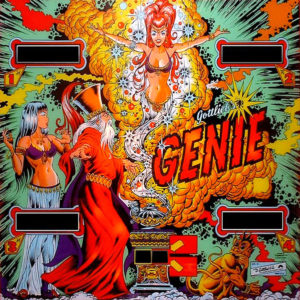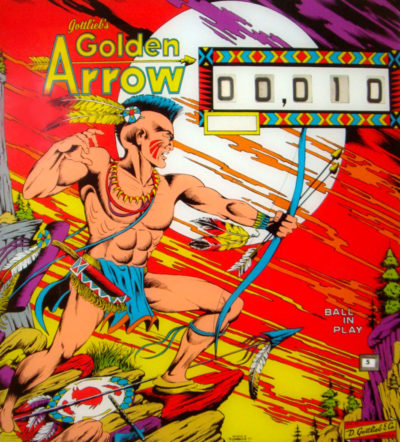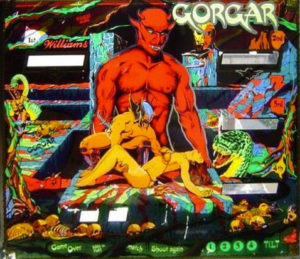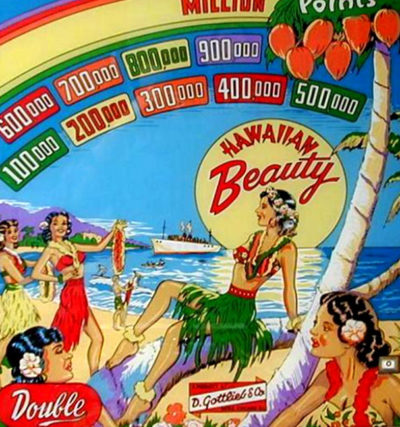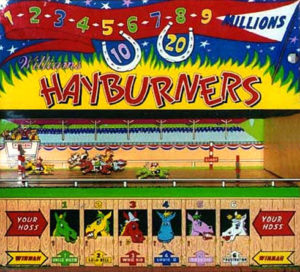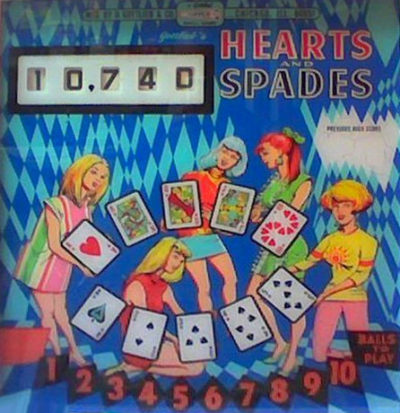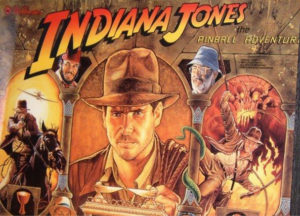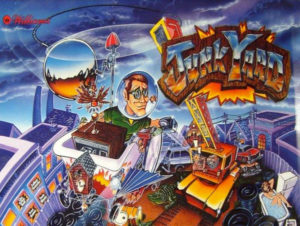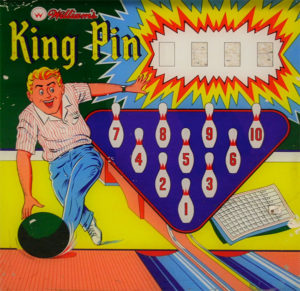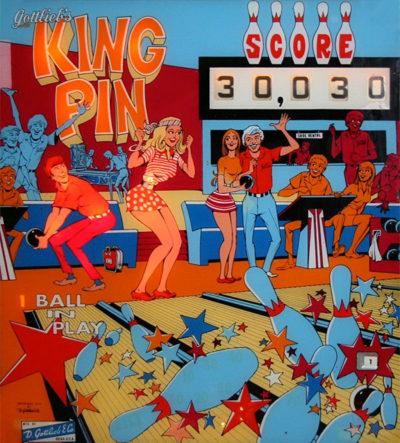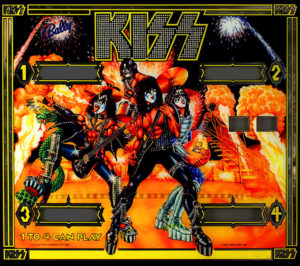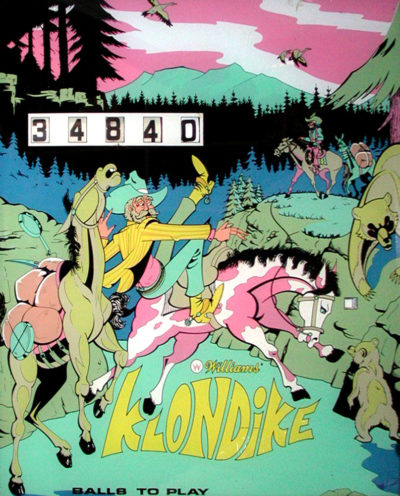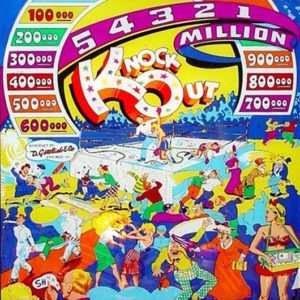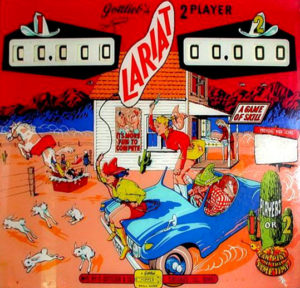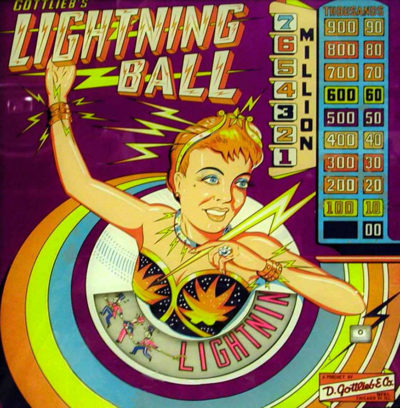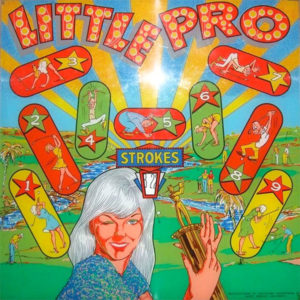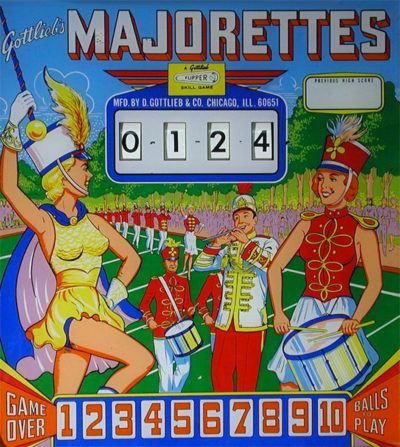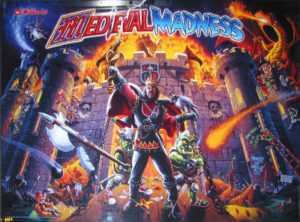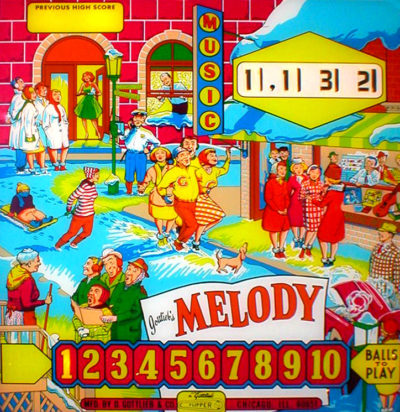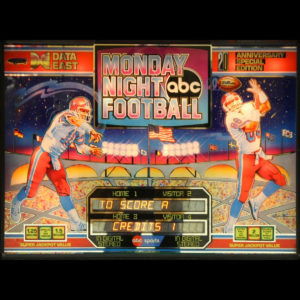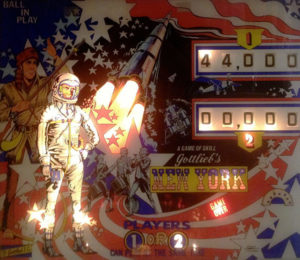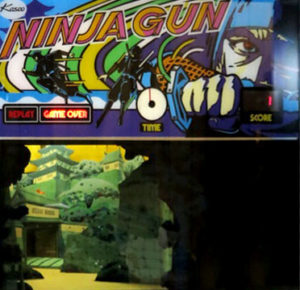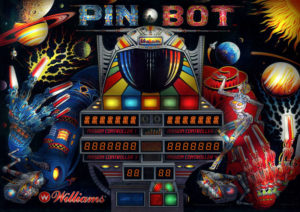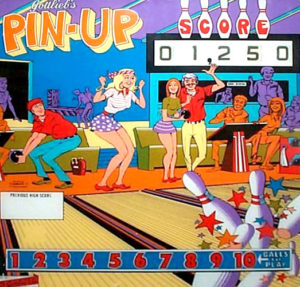-
This game was a breakthru game for Williams in January. It was designed by Steve Ritchie with art by Constantino Mitchell. Flash was the first game to have a continous background sound during play and the crescendo of the sound sped up as you advanced thru the game. This is also the first game to use “flash lamps”, which are higher voltage lights that really make a presence when they light. The first thing you notice on this non-speaking game is, when you shoot the ball from the plunger, the ball travels diagonally across the playfield and ends at the top of the playfield from left to right. The top rollovers consist of 4 numbers. If you hit 1-3, you get a double bonus; all four made gives a triple bonus. 19,505 games were made, a big production run. This game also has the advance bonus eject hole, drop targets, and, of course, the bright “flash” show when activated. This game was a main staple in arcades of the ’80s.This Gottlieb game is one of the five in the museum of the “flipper” series from Gottlieb. These games are all add-a-ball games. The layout of this game parallels a future Gottlieb classic by the name of “Buckaroo” (also in the museum). 1,550 of these machines were manufactured. Wayne Neyens designed the game and Roy Parker established the art package. Fifteen targets on the roto-target are present and spinning the roto would bring up new numbers to complete. If you are skillful enough to sequence four numbers in a row, an extra ball is awarded. The bull’s-eye target awards an extra ball also. Each time an extra ball is awarded, the backglass animation activates. The cowboy shoots at the targets, which causes them to spin. No match feature here and tilting the game forfeits the ball in play as well as a future ball in play.This wide-body solid-state game was a high-production model with 6,800 units produced. The artwork was Gordon Morison’s creation with Ed Krynski penning the playfield. This pre-vocal machine is jam-packed with features. A mini playfield in the upper left consists of drop targets which, when completed correctly, light extra ball and special targets on the main playfield. Hitting a, b, c, and d on the top rollovers lights an extra ball feature on the mini playfield. Hitting the yellow star drop targets advances the multiplier bonus up to a 5x level. Interesting side drain configurations as well as the potential to score the kick-out hole playfield bonus prior to draining a ball is interesting. Five flippers grace the game. All in all, a great package and interesting flow for an early wide-body creation.Here’s another example of a Gottlieb single-player mechanical game when all the other manufacturers during this period were developing solid-state computerized machines. Ed Krynski is the designer with Gordon Morison the artist of choice for this model, one of 1,530 machines made. The machine itself is a classic ’70s. Ten numbers is your goal here. You achieve these ten targets by hitting and rolling over the appropriate spots on the playfield. Hitting the spinner spots the numbered target the spinner stops on. If you’re lucky to complete the targets, the special lights up and advances through the ten numbers. Hitting the lighted number with “special” lit means more free time playing the game. Score for replays is your second goal. Nice artwork in a single player game, one of the last produced.This game was a breakthru game. It is the first-ever talking pinball machine. Games of this era had synthesized sound, but this game spoke. The speech wasn’t very clear or very wordy, as memory chips of this era couldn’t hold too much information compared to today’s games, but it was a sensation for Williams. The production run for the game was 14,000 units. It was designed by Barry Oursler with art by Constantino Mitchell. The top three rollover lanes would, if completed give up two, then three times bonus. The snake pit in the upper-left playfield has a magnet under it, which captures the ball for bonuses and Gorgar’s chance to use his seven-word vocabulary. Spelling out the word “Gorgar” makes the monster say his name and increases bonus values. This game also incorporates the background noise made famous in the Williams game Flash (in the museum). This time the background sound is of a heartbeat. It gets faster and faster as you advance.If there was a very pretty game manufactured in the ‘50s, this is it! Hawaiian Beauty was designed by Wayne Neyens with art package by none other than Roy Parker. 900 of these machines were screwed together in the Chicago factory. The game was initially called “Monkey Shine” but was later changed. This game also features the infamous “double” award. If you inset two nickels at the beginning of the game instead of the usual nickel, each won replay would score two games or double the winnings instead of one game. More coins in the coinbox was the hope of the arcade owners. The playfield is interesting in this game. Two blocked gobble holes at the top of the playfield would score 500,000 points and light lower side exit special lanes for replays. Hitting the 1-6 sequence at the top of the playfield would advance the rollovers to score 100,000 points if rolled over. Points as well as score won games.12,716 of these Mark Ritchie-designed games were produced in wide-body format. This machine has a lot of the action associated with the first three Indiana Jones adventures produced by Lucas and Spielberg and is rated in the top 10 machines of the ‘90s. Four multiball modes grace this machine as well as a ton of video clips designed by Brian Eddy. Twelve different scenes from the movies are represented. Completing these scenes awards a six-ball multiball sequence. A three-ball multiball sequence may be had by hitting the center drop targets and popping a ball into the drop hole behind them. The path of adventure is lit by hitting the letters in the word “adventure.” Doing so opens the path up the right ramp to the tilt-a-matic playfield in the upper left. The object here is to use the flipper buttons to guide the ball to glory.Gottlieb Joker Poker pinball. An interesting design, and only made in a 4 player version (no 2 player, unusual for Gottlieb pinball). One bank of five ace drop targets, one bank of four king drop targets, one bank of three jack targets, one bank of two queen drop targets, and a single ten drop target. Pretty cool pinball design really. Two pop bumpers, one slingshot, two 3″ flippers. They made 820 Gottlieb EM Joker Poker pinballs.Playfield Layout There are two standard flippers and standard return lanes in the usual positions. The inlanes can be lit to start Crane Hurry-up. The outlanes have quite large openings, and each outlane can be lit separately for a “Ball Recycle”. Above the left out/inlanes there is a popper which returns the ball to the left inlane. Most of the shots that take balls under the playfield return the ball here. On the playfield beside this device is a bank of three standup targets with blue lights in the playfield in front of them, which, when completed, lights the left outlane Recycle. Above this there are two ramps with entrance side-by-side. The far left ramp leads to a toilet, which counts the spins the ball takes inside it before falling under the playfield. The inner ramp carries the ball around the back of the playfield toward a VW bus in the back right corner; a diverter can cause the ball to be temporarily held here or to return directly on a habitrail to the right inlane. This ramp also has an open side which allows slow shots to fall through to an area not otherwise accessible, which dribbles down into the hole in front of the dog. Lights in front of these ramps indicate various available shots. In the center of the top of the playfield is this game’s main feature. The “Crane” is a pinball hanging from a chain. The chain hangs from a bar (which is decorated to look like a crane) that goes into the back wall of the game. This ball can be raised or lowered, to allow the pinball to pass under it, or block its path. The bar itself can move side-to-side and up-and-down slightly, in addition to the wild motion the ball has. Around this, arranged in a semicircle, are 2 banks of 3 standup targets with an opening for another shot (which goes around a corner and under the playfield) between them. Above these there is a row of 5 larger “car” standup targets, with no gap. The crane ball can be hit into these higher targets. Several lights in front of the crane ball indicate shots available on the crane ball (by hitting it into the car standups) or in the opening behind it. There doesn’t seem to be a name for this opening (in some mode, I forget which, the game calls it the alley, but the playfield calls the DOG scoop the alley), so I will call it the center shot. Below the right side crane standups there is an up-scoop which usually drops the ball onto the bus ramp’s habitrail to the right inlane, but a diverter can send it to the dog instead. The dog is a decoration just in front of the bus; when the ball goes to him, it falls into a hole in the playfield in front of him, and if the ball was supposed to be there, a video mode starts. Lights in front of the scoop spell out D-O-G. Just to the left of it there is a small standup target, the Toaster Gun target. Below and slightly to the right of the scoop entrance, there is a sinkhole called the Sewer that can be entered from almost any direction. Lights in front of it indicate a variety of awards which can be available here, including Extra Ball and Adventures. The adventures themselves are indicated by a separate row of lights across the playfield, below the lights for the ramps, crane, and scoop. Below the Sewer there is a bank of 3 blue standups; these light the right outlane Recycle and are similar to their counterparts on the other side of the playfield. The plunger (which is a combination manual and autoplunger) shoots the ball through a spinner and into a sinkhole, which, like other holes on this game, takes the ball to the left inlane feed. Junk In the middle of the lower section of the playfield, in addition to lights for “shoot again” and autofire, there is a blueprint with 10 different pieces of junk marked with lights. Some of the pieces combine to make various contraptions. The junk consists of: Hair dryer, toaster, cuckoo clock, television, weathervane, fishbowl, propeller, fan, bathtub, and bicycle wheels. The game begins with the toaster already awarded. The combinations are: • Hair dryer + toaster = toaster gun • television + weathervane = radar • bicycle wheels + bathtub + fan = jalopy • fishbowl + jalopy = submerger • propeller + jalopy = flying machine There is an extra ball awarded for collecting a certain amount of junk, which is on a percentage; on the game I play it’s awarded on the third junk item. Collecting all the junk lets you enter your initials as junk champion at the end of the game. The current junk champion’s initials are shown on Spike’s collar when each dog video mode begins. Helpful hints At various times during the game, an angel appears on the left of the DMD or a devil appears on the right, and they make some comment. Whenever you collect junk, one or both of them appears and advises you what to collect next. (If your first junk item is anything other than the hair dryer, both appear, the angel advising you to get the hair dryer and the devil advising you to get a part for the radar.) One of these also announces each time an invention is completed, or when an adventure starts.This game is a classic and is rated # 5 in collectible machines of the ‘60s. The game was created by Wayne Neyens with artwork by Roy Parker. Production run was 2,875 units. The main action in the game comes from the four in-line kickout holes set across the center playfield. The object of the machine is to hit a suit of four cards vertically under the kickout holes. If you get all four, a hole will randomly light up to score a free game (i.e., a special). The challenge here is to sink the ball in the kickout holes once a special is lit. All four holes can light up if you’re lucky enough to score all 16 cards. Finally, another special in the top rollover lanes randomly lights if you score just the four top cards on the pattern of cards. Score also was a factor as dropping balls in the kickout holes with many cards lit scored a lot of points very quickly.This very collectible game of the ‘70s was another in a series of celebrity-themed tie-in games Bally found license to produce. 17,000 units were made, a sizable number for the day. A prototype speaking version of this game was made ahead of its time but failed to be marketed. The object of the game is to spell out the name KISS. If you complete four times, a super bonus is awarded. Do it again and a colossal bonus is awarded. A third time awards a replay and a ton of points…which can be doubled if the 2x value drop targets are completed. The A, B, C, and D targets also can award extra balls and specials. The left drop targets award the KISS line when completed. All in all, an exciting game with great graphics but no speech. Talking pinballs finally made the scene with the release of Gorgar (in the museum). Replays are also awarded by score or matching. Matching is the process by which the last two numbers of your score match the generated number produced by the game.This game was produced in December of the year and designed by Harry Mabs with artwork by Roy Parker. 3,000 of these machines were made. The unique feature built into this machine is the animation unit in the top center of the play field. Two mechanical men are represented as boxers in a boxing match. Lights illuminate the bout when a knockout is scored by rolling over a “KO” rollover, a “KO” target, or completing bumpers 1 to 5. This game is one of the first examples of pinball animation. Another feature of the game is the pop-up bar at the bottom of the play field, preventing you from losing your ball in play for an extended period. Since the gap between the flippers is so massive, this addendum to the play field was installed to prolong the play period of the ball. A special feature is included in the game as well as a replay if 15 knockdowns are scored in one game and a replay for every knockdown scored thereafter.Wayne Neyens and Roy Parker again teamed up to create this pretty late-‘50s pin with an animated backglass. 950 units were made. The playfield has two gobble holes, which award 100,000 points for each rollover completed. If all six rollovers are made, a replay is awarded and the gobble holes are special holes. The main feature of the game is advancing the lightning ball backglass spelling. Each time you make the three colors on the playfield via rebound rubber or rollovers, the unit advances one step. If you are skillful enough to complete the lightning ball spellout, a replay is awarded, and each time you make the three colors to advance the letter, another replay is added. It’s not an easy task to complete. There’s always beating the game by scoring or matching. This game was somewhat retro as it has backglass light scoring, since Gottlieb already used reel scoring.Mata Hari was released in April of the year and designed by Jim Patla with artwork accolades going to Dave Christiansen. 16,200 of these machines were produced in the new solid-state format (as seen in the museum) as well as bunch of electromechanical machines (170, to be exact) to keep the non-computer savvy operators happy and buying machines they knew how to fix. This machine before you is one of the finest examples of this ultra-rare mechanical format. Like the solid-state version, the center kickout hole scores 3,000 points and each successful shot in the hole advances the bonus multiplier. The A and B skill shots advance the horizontal sequence of increasing values in the center of the playfield. 50,000 points are awarded when a battery of drop targets is hit. If both batteries are knocked down, the drop targets reset and hitting all again awards the replay. Score is another replay option.Flippers (2), Pop bumpers (3), Ramps (2), Autoplunger. A left-side catapult propels ball airborne into a habitrail. Two pop-up trolls in playfield become active during “Trolls!” mode. Tina Fey (of “Saturday Night Live” fame) did the voices of the “Opera Singer” princess and the Cockney-talking princess, and Andrea Farrell did the voices of the Jewish princess and the sexy princess. Greg Freres was the voice of the jousting announcer and one of the trolls while Francois Du Grim was voiced by Vince Pontarelli who also did the other troll. Look no further! This game, in my humble opinion, takes the prize as the most sought-after, inventive game of the ‘90s! Brian Eddy designed this machine with 4,016 units screwed together. The action, endless vocal calls, the exploding castle, the pop-up trolls and the moat and dropping gate make this machine one of a kind. The value of this machine is going through the roof, more than doubling its original price. The six kings from six different castles must be defeated by attacking the castle walls. Defeating a king makes the fort collapse. It’s nearly impossible to complete this feat. The princess must be rescued up the upper right ramp when activated (the princess’s vocals are none other than Tina Fey’s voice). Many multiball challenges await. The trolls must be hit many times to be conquered. The whole package is artistically and musically amazing. Most of these machines are tucked away in home arcades at this point. Enjoy!October was the birthdate for this machine. It was designed by Ed Krynski with artwork by Art Stenholm. Low production run of 550 units. This is an add-a-ball game, the replay version being called Sing Along. This game was a variation on a classic Gottlieb game Kings and Queens, in that it contains the four side-by-side kickout holes made popular in 1965. Here, the object of the game is to complete four same-colored numbers vertically in a row to randomly cause the kickout hole to light to score an extra ball if you land in the hole when it’s lit. If you didn’t win a ball, each light in the column would award 10 points. If you have most of the lights lit, a run at the kickout holes awards a lot of points in a hurry which, in this game, also awards extra balls. One center target is also incorporated into the game, awarding 100 points when hit and lights the pop bumpers for higher scoring.This electromechanical two-player game was designed by Steve Kordek. The game reminds one of an older game, as an animated golfer is on board that you aim to hopefully sink a ball in the appropriate hole. The nine scattered holes are tough to sink, especially the back ones. The lower your score in strokes, the better with this game (no handicap is given). Free games may be awarded set by the operator for low-stroke counts after completing so many holes. A neat and rare game.This rare add-a-ball game was released in April. It was designed by John Osbourne with artwork by Gordon Morison. A minimal total of 270 units were soldered together at the time. This is a small number for a pinball run. The replay version had a much larger production and the name of that game was Hit The Deck. As you can see from the backglass, Gottlieb tried to experiment with a score reel that was completely different in coloring. This was to attract attention to the game and attract quarters. The object of the game is to roll over the red number and/or black number sequence inherent in the game. If you are skillful enough to get the 9 to Ace sequence, some wow options will light up to score extra balls. A kickback feature is incorporated into the game in the upper-left area. This single-player game is challenging and a rare sight to see.Kasco Manufacturing Company produced about eight machines of various themes in their productive commercial life. This machine is the most popular of the games they made. This shoot’em up game awards a free play if a score of 80 is made. The game board is elaborate for its day and looks 3-D. Blacklight, holograms, and mechanical chain link drives are all synchronized at different speeds (the faster the ninja moves, the more potential points you can earn if you hit one). Hitting a ninja produces a flash of light and points. Audio enhances your experience. Lighting colored artwork from behind a mirror creates the animation effect seen in this game. There’s only eight molded targets in the game, but it appears a lot more are present due to the computer’s timing of their action. Give it a shot!Williams produced this game in October with 7,053 units produced. Norm Clark designed the game and Christian Marche did the art package. This four-player electromechanical game is based on the game tic-tac-toe. Making 3 x’s or 3 o’s in line or diagonally lights the eject holes to award an extra ball and 5,000 points. Making the A and B rollovers lights the center target. Hitting it opens the gate and 1,000 points. A bonus feature is incorporated into the game and this is awarded when the ball drains. Lighting all the squares activates the side rollover lanes to score a replay. Score and matching are also incorporated into the game. A fast playfield design and fun to play.Official Baseball, Williams #232, 2/60, two players, woodrail with players on the playfield and animated umpire and pitcher, plus a running man unit. Uses 3/4″ balls. Very often the playfield men get broken from the ball play (or the catcher is just plain missing!) A very cool woodrail (maple side rail) baseball arcade game with hole style scoring (opposed to the 1963 and later target scoring scheme), and a very good looking game. Two player game, so competitive play is encouraged. High score is kept, with a default of 15 runs as the minimum high score to beat. Game can be set for one to three innings per game. Game uses a buzzer which sounds between innings and players. Most of the players have lights under their fielding hole. If the light is on, the runner advances if the ball goes in this hole. If the light is out, the field hole is an out. Whether the light is on or off is determined by how many players are currently on base (via the running man unit in the backbox). So hitting to the first basemen’s field hole could get the player an out or a single. Official baseball is easily the best looking of all post-WW2 pitch and bat baseballs. With the metal playfield men and classic design, it’s a handsome game. It is not though the best playing of the Williams pitch and bats. Since it does not have a home-run deck (like most of the other Williams p&b games), it’s not riveting from a game play perspective. But the pitching unit (the umpire hands the ball to the pitcher, and then the pitcher moves forward to pitch the ball).This machine was a big hit for Williams with 12,000 machines created. A skill shot starts your adventure with different point values. A three-bank drop target or single right target advances the planets lit in the playfield. If you advance to the lit planet, a free game is your reward. The light grid, if hit when a solo target is lit, opens the visor. Otherwise, hitting all the lights opens the visor. Locking two balls in the “eyes” of the robot starts two-ball multiball. Lock one ball in one eye and shoot for the left solar ramp. Advance the bonus value by making the left ramp loop when the visor is down. This game is fun, challenging and the vocals egg you on throughout your adventure.Gottlieb hatched this add-a-ball machine from the skunkworks in April of the year, designed by Ed Krynski and artwork by Gordon Morison. This single-player machine has a bowling theme and only 715 units were produced at that time. The replay version of the game was called King Pin and many more of these machines were produced. The theme of this game is the drop target completion. By carefully aiming the four inherent flippers on board the playfield, one must try to complete the horizontal row of targets. Doing so will reset the targets and the wow feature activates, giving you a shot at the accomplishment of winning extra balls. Score is another way to pop free balls. The ten drop targets are not so easy to complete and the wow feature advances when you roll over the star rollover. This game is challenging, but a beginner can have ample fun with the machine.
-
This game was a breakthru game for Williams in January. It was designed by Steve Ritchie with art by Constantino Mitchell. Flash was the first game to have a continous background sound during play and the crescendo of the sound sped up as you advanced thru the game. This is also the first game to use “flash lamps”, which are higher voltage lights that really make a presence when they light. The first thing you notice on this non-speaking game is, when you shoot the ball from the plunger, the ball travels diagonally across the playfield and ends at the top of the playfield from left to right. The top rollovers consist of 4 numbers. If you hit 1-3, you get a double bonus; all four made gives a triple bonus. 19,505 games were made, a big production run. This game also has the advance bonus eject hole, drop targets, and, of course, the bright “flash” show when activated. This game was a main staple in arcades of the ’80s.
